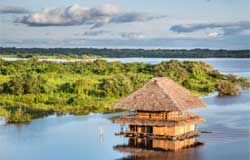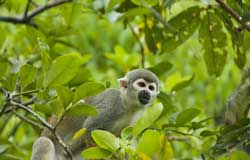Vive al máximo tu experiencia en la Amazonia. Te presentamos el set de actividades más variado de la región que incluye: cultura local, ciencia, aventura, naturaleza y excursiones para familias. Los horarios de las actividades se encuentran disponibles en el lodge.
Ciencia
• Descubriendo una nueva especie: Ayúdanos a revelar las maravillas de la naturaleza, se parte de la ciencia y ten la oportunidad de descubrir una nueva especie, hay una increíble diversidad en la selva Nos reuniremos con los investigadores residentes en el lobby para recibir una charla breve del tipo específico de especie que estamos buscando, nos enseñaran como identificarlos y proporcionarán el material necesario para colectarlos, caminando aproximadamente 15 minutos del albergue se encuentra la trampa de luz donde podrán observar la increíble diversidad de insectos que alberga la Amazonía. Con nuestros ojos atentos buscaremos la especie elegida y las colectaremos, si tenemos suerte descubriremos una nueva especie.
• AmazonCam Tambopata: Estamos construyendo una Gran Red para resolver grandes preguntas, podrás convertirte en investigador por un momento y explorar el mundo de las cámaras trampa que nos darán la oportunidad de ver lo que nuestros ojos no alcanzan, en un gran vecindario. Caminaremos cerca de 20 minutos hacia la collpa de mamíferos uno de los lugares favoritos de la fauna. Ayudaremos a los investigadores a recoger la información anterior e instalar las nuevas cámaras, las probaremos para ver que estén funcionando bien y al regreso al albergue podremos ver lo que colectamos
• Tambopata Aerobotánica: Logramos tener la copa de los árboles a nuestro alcance. Experimenta la increíble diversidad de los árboles y plantas de la Amazonia desde el aire. Lanzaremos un Dron desde la torre de 35 metros de altura y lograremos una vista incomparable, ideal para completar la experiencia de la torre, caminando a 20 minutos del albergue y alcanzando la copa de los árboles observaremos como se lanza el Dron hacia su ruta diaria y lograremos fotos y videos increíbles desde el aire.
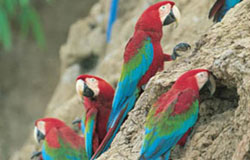
Aventura
• Mountain Biking: Experimenta el entusiasmo y la belleza del bosque amazónico a través de una trocha de 10 kilómetros especialmente diseñado para bicicletas. Proveeremos una bicicleta GT, casco, botella de agua y tu propio guía.
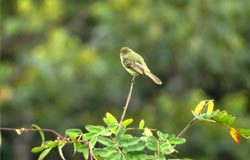
Naturaleza
• Collpa de Guacamayos Chuncho: Toma medio día de excursión hacia una de las más famosas colpas de Tambopata. A 2 horas en bote desde Refugio Amazonas este maravilloso lugar es visitado por diferentes especies de guacamayos, loros y periquitos. El guía nos ayudará a identificar las especies vistas en el rio y en la collpa con la ayuda de binoculares y telescopio. Gran oportunidad de observar uno de los espectáculos más impresionantes de la naturaleza.
• Sunset Cruise: Los atardeceres en la amazonia son espectaculares y uno de los mejores lugares para observarlos es desde un bote en el rio. En la tarde su guía los llevará para un paseo tranquilo de aproximadamente 2 horas en el río Tambopata, también recibiremos información sobre la dinámica de los ríos mientras buscamos vida silvestre antes de disfrutar el atardecer.
• Visita al Lago: Vamos a remar por el lago en una canoa o un catamarán, en busca de fauna especialista en cuerpos de agua como el Hoatzin, caimanes y camungos. Con suerte podríamos llegar a ver los lobos de río que pertenecen a este tipo de hábitat, remaremos durante un par de horas para apreciar este increíble ecosistema.
• Canopy Tower: Una caminata de media hora desde Refugio Amazonas nos lleva a la torre de dosel, de 35 metros de altura y una escalera con baranda proporciona un acceso seguro a las plataformas. La torre ha sido construida sobre terreno alto, por lo tanto, se puede observar una impresionante vista del horizonte de bosque primario extendiéndose hacia la Reserva Nacional de Tambopata. Desde aquí podríamos observar distintas especies de aves como tucanes, guacamayos, rapaces entre otras especies.
• Collpa de Loritos: Un viaje en bote de quince minutos y una hora de caminata desde Refugio Amazonas encontramos una collpa de loros y periquitos. A diferencia de las otras colpas de la zona esta se especializa en las pequeñas especies. Desde un escondite se podrá observar loros y periquitos descienden en los días más claros para ingerir la arcilla. Con suerte también veremos algunas otras especies de vida silvestre en este tipo de bosque.
• Camino de la Castaña: Unos pocos minutos caminata del albergue lleva a un hermoso bosque de viejos árboles de castaña que ha sido cosechado por décadas (incluso siglos) donde los restos precarios de un campamento usado durante los meses de recolección por los castañeros todavía puede ser experimentados. Demostraremos todo el proceso de producto cosechado de la selva tropical de la colección a través del transporte de secado hasta que se convierte en producto de importación.
• Collpa de Mamíferos: Veinte minutos a pie desde Refugio Amazonas se encuentra una collpa de mamíferos. Hay muchas especies en la selva que necesitan también de estos nutrientes para su dieta diaria. Los cerdos salvajes las visitan en grupos de entre 5 y 20 y tenemos buenas posibilidades de encontrarlos ahí. Bien vale la pena la corta caminata.
• Caminata Nocturna: La mayor parte de la selva cobra vida por la noche. Esto hace que la noche sea el mejor momento del día para ver ranas extrañas y bellas, insectos y otros animales nocturnos. El guía nos llevará por un sendero que sale desde cerca del albergue durante una hora y media emocionante caminata nocturna en la selva tropical del Amazonas.
• Caminata del Overlook: Este camino de 2 kilómetros nos llevará a lo largo del río Tambopata. Podremos diferenciar claramente un bosque de Terra Firme un bosque secundario después de este paseo, ya que el camino cruza ambos hábitats. Descansando en los bancos se puede presenciar el rio Tambopata en su viaje sin prisas a través de la selva baja.
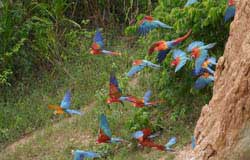
Cultura Local
• Visita a la Chacra: Cinco minutos río abajo del albergue encontraremos una chacra, propiedad del carismático Don Manuel, de la comunidad vecina de Condenado. Él cuidadosamente, siembra una variedad de cultivos populares y típicos de Amazonia - cada planta y árbol tiene un propósito.
• Camino de Plantas Medicinales: A lo largo de este camino, encontraremos una variedad de plantas y árboles que son utilizados por la población local con la misma variedad de propósitos. Vamos a aprender acerca de los usos medicinales y ancestrales de las mismas como Ajo - Sacha, Uña De Gato, Charcot- Sacha, Para-Para, Ayahuasca, entre varios otros.
• Charlas de la Amazonía: Presentaciones diarias nocturnas preparadas por el personal de Refugio Amazonas cubren las amenazas para la conservación, oportunidades y proyectos en la Reserva Nacional Tambopata.
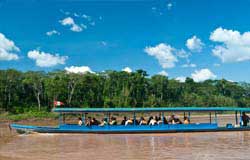
Actividades para toda la Familia
• Círculo de Fuego: La primera noche, como preludio de las próximas actividades que se llevarán a cabo con nuestro guía, nos dirigimos hacia el círculo de fuego. Una serie de lamparines iluminan el camino que conduce a través del bosque donde se encuentra el círculo de fuego. Aquí es donde está Tawa, el antiguo curandero, la casa está con todos sus instrumentos y pociones mágicas y extractos preparados a partir de plantas del bosque. Nos sentaremos a escuchar a nuestro guía a través de la historia "Ania y la Voz del Mundo" y aprender la historia y los personajes. Es el punto de partida para la aventura espera a que nosotros en los próximos días.
• La Trocha de los Niños: Ania & la Voz Mundo: Un viaje emocionante diseñado para niños entre 4 y 10 años, viajamos con nuestros guías en un desafiante camino, donde seguimos el mapa, resolvemos acertijos y encontramos pistas que conduzcan al "Tesoro de Ania" la ruta incluye la visita a las casas de ANIA y TAWA, el abuelo de los bosques. La búsqueda de la "semilla perdida", la ciudad de las hormigas y otros juegos divertidos enseñan a los niños cómo se vive en la selva, y dejan un mensaje valioso de Ania: "Una niña nacida en la selva para llenar nuestros corazones de esperanza" el concepto y la historia están registradas a nombre de ANIA, una organización sin fin de lucro con la misión de crear 100.000 hectáreas de "Tierra de niños", áreas protegidas manejadas para los niños.
• Tatuaje Amazónicos: En el albergue prepararemos una pasta de la fruta del huito y achiote para dibujar tatuajes azules y rojos oscuros en nosotros mismos. Tienen una duración de varios días.
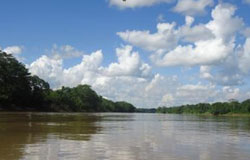
2023 Precios por persona expresados en US$:
Habitación Comfort: $1036 en habitación doble. $1355 en habitación simple.
Nota: Añadir $ 13.00 por persona para la entrada a la Reserva Nacional Tambopata.
WEATHER CONDITIONS
The lowland rain forests of Tambopata lie far enough south of the Equator to provide a cooler, drier winter season between May and October, which also happens to be the major season for international travel. The general weather conditions, are warm and humid. In Tambopata the average Díatime high temperature is between 82° and 93° F (25° and 31°C) and the average nighttime low is between 62° and 73° F (16° and 22°C).
Nevertheless between May and September, cold fronts from Argentina can sweep into southwestern Amazonia and push Díatime highs down to 50° F (9° C) and the nighttime lows to 43° F (5° C). Thus, during that season always be potentially prepared for cold and drizzle. During the rainy months of November through April, always be prepared for heavy rain that can continue for hours or Días. Around 80% of the annual average 2000 mm rainfall occurs during this season.
WHAT TO BRING
We recommend that each visitor limit gear to good binoculars; camera gear; tight-weave, light weight, light colored, long cotton pants; long sleeved, tight-weave, light colored cotton shirts; undergarments; absorbent socks; ankle-high hiking boots; sneakers; a powerful flashlight with batteries; a small toilet kit; a water bottle; sunblock lotion; sunglasses; a secure, broad-brimmed hat; 100% waterproof, head-to-ankle rain suit; insect repellent; yellow fever inoculation certificate; small denomination bills and a small Díapack.
MEDICAL INFORMATION
Yellow fever inoculation is required for travel to Tambopata. It is necessary that you bring your yellow fever inoculation certificate to prove to the airport officials in Puerto Maldonado that you are vaccinated. Leishmaniasis is present throughout the rain forests of southeastern Peru. It is a skin lesion caused by a protozoan transmitted by a certain kind of small biting fly. There is no vaccination against it but it is curable in every case. The selected cure, injections of pentavalent antimony (Glucantime), is uncomfortable. Leishmaniasis is also very easy to prevent by wearing long-sleeved shirts, pants, and repellent on exposed skin at all times, and sleeping under mosquito nets. If you are interested in receiving complete information on leishmaniasis contact us before your trip. For precautions against malaria consult your physician or a specialist in tropical medicine.It is vital that persons with medical problems or special diet requirements make them known to us well before departure.
COMMUNICATIONS
Posada Amazonas and Tambopata Research Center are in daily radio contact with our offices in Puerto Maldonado and Lima. We have HF radios at these four stations. From Lima and Puerto Maldonado we are able to communicate by fax or phone with the rest of the world. In some cases, cellular phones will have a signal when we´re standing on top of the canopy tower at Posada Amazonas.
PASSPORTS, MONEY, AIR TICKETS
You may need your passport upon arrival at Puerto Maldonado in the event authorities want to spot check tourist entries, as the local airport is officially an international airport. Upon arrival, a Rainforest Expeditions representative will collect your domestic air tickets to confirm your return flights. At the end of the trip, he/she will collect cash from you to pay for the airport tax.
MEALS
We provide all meals during the trip. Meals consist of soup or appetizers, salad, main course, dessert, and coffee or tea. All fresh fruits and salads are thoroughly disinfected before serving. We also provide at all times unlimited amounts of boiled, cooled drinking water. If any visitor has special dietary requirements, we are happy to make individual arrangements, but please notify us early. Upon request we will furnish a complete description of our menus.
ACCOMMODATIONS AT POSADA AMAZONAS
Posada Amazonas is located on the banks of the Tambopata River in the grounds of the Community, adjacent to the Tambopata National Reserve. It is owned jointly by Rainforest Expeditions and the Ese’eja Native Community of Tambopata. Posada Amazonas is built using a combination of traditional native materials (wood, palm fronds, wild cane and clay) and architecture and modern Día eco-lodge technology. The lodge itself consists of a complex of four sections: rooms, dining area and kitchen, relaxation area and internal support facilities. The entire roof of the lodge is constructed using high quality crisneja palm fronds, whereas the floors are of tropical mahogany. The rooms complex is built of four 9 X 24 meter structures with six rooms per facility, for a total of 24 double bedrooms. The rooms are 7 x 4 meters so they can comfortably hold three beds, although they are set up for two. The walls dividing each room are built using cane and clay, and extend from the floor to about 2.5 meters height making each room private. The combination of clay and cane achieves two important objectives: regulating heat and providing a charming final appeareance. However, sounds can be heard from room to room. The side that looks out to the forest does not have a wall or screening of any kind, acting as a large window facing the forest. The reason we have been able to incorporate this "luxurious" design into our lodge is because mosquitos are not really a problem around the lodge clearing and the open section allows for an intimate contact with the rain forest. A second small window on the opposite side, set up very high, keeps the rooms well ventilated. Beds are sized for Americans or Europeans (1.05m X 2.05m) with mosquito nets. Each room has a private bathroom with cold water only. Rooms and bathrooms are separated by drapes. The dining room and lounge is spacy and offers ample area for resting and socializing.
ACCOMODATIONS AT THE TAMBOPATA RESEARCH CENTER
Tambopata Research Center is located in a half hectare clearing 50 meters from the Tambopata River and 300 meters from the macaw clay lick. It is composed of four interconnected, thatch-roofed buildings designed after traditional low-impact native architecture. All buildings and interconnecting passageways are raised on four-foot stilts built from palm trunks. The main building is a 33 foot by 100 foot platform divided into 13 double rooms. Each bedroom is furnished with two beds draped in mosquito nets, a chair, a night table with a kerosene windlamp, and a table for luggage and clothing. Each room does not have a wall on the side that looks into the forest: it is also designed to have an optional, permanent, unobstacled view of the forest surrounding the clearing in order to maximize wildlife observation time. To the left of the main building a 20 foot-long, roofed passageway connects to the bathrooms containing flush toilets and shower stalls. To the right of the main building a 15 foot-long, roofed passageway connects to the dining room and meeting room which in turn is connected to the kitchen.
ELECTRICITY
Neither Posada Amazonas nor Tambopata Research Center have electricity. Light is provided by numerous kerosene lamps and candles. A generator is turned on once a Día to recharge batteries for tourists or lodge facilities. At night it is very dark, so we recommend good flashlights.
TRAVEL BY BOAT
Our boats are 20 foot canoes with foldable couched seats and a roof. They are powered by 65 hp outboard motors which allow for a travel time of two hours from Puerto Maldonado to Posada Amazonas and four to five hours from Posada Amazonas to TRC. Passengers are protected by the sun and rain by the roof but we suggest keeping your rain gear and sunblock handy in case the sun’s rays or rain drops come in slanted. There are life vests in every seat.
EMERGENCIES
In case of emergencies we have a first aid kit that is equipped to deal with most cases that may reasonably arise in the area. For snake bites, an unheard of at Tambopata so far, we have a stun gun, extractors and an anti-venom at the lodges. In case of evacuation, we are three and a half hours from Puerto Maldonado and medical attention, in case we´re at TRC.
EMERGENCY CONTACT
In case of a true emergency, friends or family should contact you through the lodges' office in Puerto Maldonado:
- Phone/Fax (5184) 571056
- Mobile Phone (5184) 9971897
ABOUT PUERTO MALDONADO
Puerto Maldonado is a small jungle boomtown of about 50,000 people where life goes slowly amidst the chaos. It is fun for a Día or two and with that in mind we provide some basic information of relevant Puerto Maldonado affairs.
In Puerto Maldonado we recommend two hotels: Cabaña Quinta in Cusco 535 and Wasai Lodge on Calle Billinghurst. Both offer simple accommodations and are inexpensive. Good restaurants include: Pizzeria Chez Maggy (pizzas) on the Main Square, La Casa Nostra (sandwiches and snacks) on Leon Velarde 515, El Califa (local food) on Piura 266. For a beer we recommend Oasis, on the Main Square, and for a dance Witite is the place to go, just off the Main Square on Leon Velarde.
Taxis are three wheeled motorcycles with a back seat. They charge half a dollar for most rides ($2 to the airport.).
The post office, Serpost, is located at Av León Velarde 6th block. The Telefónica office is on the 7th block of Puno. Internet access is available at Compunet or Data System, both of which can be found on Leon Velarde.
Banco de Crédito has a Visa ATM and will change US cash without a commision. Banco de la Nación gives cash on MasterCard and reasonable rates for traveler's checks. Both banks are located on the Plaza de Armas. There are money exchange houses on Calle Puno.
For medical emergencies, Hospital Santa Rosa (tele # 57-1019/57-1046) is located at Cajamarca 171 and Essalud is located at Cajamarca 341, Tel 571440. Pharmacies, Farmacias, are scattered throughout town and any medicines that may be needed are very likely to be found there.
WILDLIFE OBSERVATION IN THE RAIN FOREST
Tambopata is one of the world´s most diverse wildernesses. It is also one of the best preserved. However, the vast majority of the rain forest´s diversity is in the form of insects. The world record diversities of birds and mammals, are mostly in the form of small, unspectacular species. Large spectacular species are rare, shy, unpredictable and very difficult to see, with few notable exceptions. So don´t come expecting the wildlife densities of the African savannahs or the Antarctic peninsula. We aren´t in Jurassic Park or Disneyland, either.
Nevertheless, Tambopata is diverse and it is well preserved and exciting encounters do occur on a regular basis. At Tambopata Research Center, you will have some of the Amazon´s best chances of seeing jaguar, tapir, giant river otters, harpy eagles, macaws, etc. However, the Amazon´s best chances for some of these species are very slim, but they do occur. In the year 2000 for example we have seen 16 jaguars, perhaps the most difficult to see of the aforementioned species. For detailed descriptions of these and other species and our encounter rates, please check out the section on miscellanous information.
Another important thing to keep in mind is that when you do encounter wildlife, you will not have the clear, ample field of view of the African savannahs or Antarctica, nor the reposed exhibits of a zoo. In all likelihood you will see the wildlife through branches, leaves, vine tangles and dense vegetation, scampering, stampeding, flying or leaping away from you, at heights of up to 40 meters for less than a minute. But wonderful encounters do happen. Of the 16 jaguar encounters mentioned above, one was of a jaguar eating a dead tapir, at 20 yards seen for 15 minutes by 8 people. Another one was of a jaguar sleeping on the beach in front of the TRC. Our driver did three return trips to show everyone at the lodge, including staff, the sleeping jaguar. It was even filmed by a crew from the BBC! The next Día, it was there again.
So, do not expect wildlife to be encountered as it is found in North American parks. Come relaxed, with your eyes open and lots of curiosity. You will be in a place where every horizontal and vertical meter of forest probably has hundreds of species of organisms, different from one meter to the next. Just that thought should keep your sense of wonder alive throughout the trip. Then, all of a sudden, you will see that jaguar.
WILDLIFE ENCOUNTER CHART
The first and second column of the following table summarize encounter probabilities for Tambopata’s most spectacular wildlife species based on over 300 Posada Amazonas and 200 Tambopata Research Center groups operated in 2000. The third column specifies Tambopata Research Center’s wildlife encounter probabilities relative to five other lodges in the region based on a two year study conducted from 1997 to 1998. The number of times each species was encountered by the group of scientists was tallied and then compared to each of the other lodges’. The number in the column indicates TRC’s position relative to the other five.This data was taken from Chirs Kirby’s preliminary unpublished report of the TREES-RAMOS project.
BIRDWATCHING AT TAMBOPATA
A typical week long trip to Tambopata, with a good birding guide, should yield around two-three hundred species. When travelling with an interest in birdwatching, i.e. when you want to dedicate most of your Día to actively seeking and identifying birds, please let us know beforehand so that we can assign an appropriate guide. Also, keep in mind that although Posada Amazonas is a good birding location, Tambopata Research Center is superior because it offers a greater habitat variety at very accessible distances, and more importantly, it is located in forests that have been unhunted for decades, thus harboring carrying capacity population of large "game" birds: guan, currasow, macaws, etc. If you do not have the minimum five Días required for a solid Tambopata Research Center itinerary, then Posada Amazonas is a good three or four Día substitute: it offers lake birds, a canopy tower and parrot clay licks. Also remember all programs to Tambopata Research Center, spend at least two nights at Posada Amazonas, giving you a chance to bird the lake and climb the canopy tower.
PHOTOGRAPHY IN TAMBOPATA
The Amazon, with its magnificent scenery and diversity of fauna and flora is a photographer's paradise. However it is a challenging environment for natura and wildlife photography. The first challenge photographers will face is with their camera equipment. Even before the first wildlife encounter, you will have to deal with elements that can cause havoc with your camera equipment. The high level of humidity, the ever changing weather conditions and even plastic-melting insect repellent will be a challenge to even the most reliable equipment.
The second challenge comes in the form of the wildlife. Even though many tourists/photographers have left the lodges with some very good images of macaws, river otters and even the extremely rare jaguar, we feel that it was because of good luck and being at the right place on the right time. Photography in the rain forest is a painstaking process and a game of long waits and Zen-like patience. Most people arrive at Posada Amazonas and the Tambopata Research Center after having viewed documentaries of the Tambopata area produced by the Discovery Channel or the BBC and have seen the pictures taken by famous professional photographers like Tui De Roy, Franz Lanting, Andre Bartschi or Heinz Plenge. These photographers visit the area on many occasions and spend months working to capture their images relying on climbing gear, tons of scaffolding, laser sensitive devices to detect movement and the expert help of teams of Rainforest Expeditions' staff and guides. It is a natural but unrealistic reaction to believe that a person with a good camera and some powerful zoom lenses can achieve the same results in a visit of a few Días.
In general, you will require lenses above 300 mm to produce good wildlife photography. ASA 200 film or above is recommended for the rain forest where it tends to be dark. For macrophotography, a flash will be required often. To make sure your equipment is protected from the elements, we recommend the use of river bags or waterproof camera cases. The use of dry bags and silicon gel are highly recommended to alleviate the problem with humidity, rain and the occasional water splashing in the canoe during the trips on the river. The use of a tripod at the clay lick is recommended and lenses ranging from 500mm to 1000mm are necessary for the clay lick. The use of flash is not recommended when photographing the macaws at close range. With the large amount of visitors trying to photograph the "chicos" at the lodge, the strong light from the flash will damage their vision.
READINGS ON TAMBOPATA RESEARCH CENTER
- MACAWS WINGED RAINBOWS. NATIONAL GEOGRAPHIC (USA). January, 1994.
- THE MACAWS OF TAMBOPATA. BIRD TALK (USA). June, 1994.
- HOMELESS MACAWS. INTERNATIONAL WILDLIFE (USA). September, 1994.
- ONE OF NATURE'S GREATEST SPECTACLES. WILD BIRD (USA). December, 1994.
- DIE ENGEL DES GRUNEN HIMMELS. TERRA (Germany). April-May-June, 1999.
- CONDE NAST TRAVELER. Winner. ECOTOURISM AWARD. July 2000.
READINGS ON POSADA AMAZONAS
- MY TREETOP BRUSH WITH A HARPY. INTERNATIONAL WIDLIFE (USA). July/August 1998.
- LEARNING BOTH WAYS: LESSONS FROM A CORPORATE AND COMMUNITY ECOTOURISM
- COLLABORATION. CULTURAL SURVIVAL. (USA). Summer, 1999.
- THE WORLD'S ULTIMATE OUTPOSTS. AUDUBON (USA). September - October, 1999.
- CONDE NAST TRAVELER. Winner. ECOTOURISM AWARD. July 2000.
